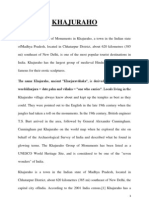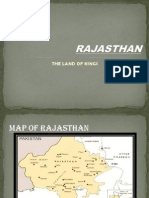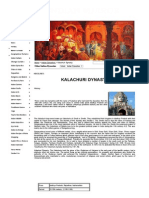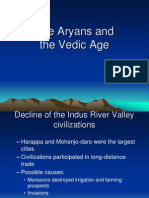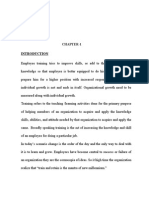Chitra Koo T
Chitra Koo T
Uploaded by
suryakantshrotriyaCopyright:
Available Formats
Chitra Koo T
Chitra Koo T
Uploaded by
suryakantshrotriyaOriginal Title
Copyright
Available Formats
Share this document
Did you find this document useful?
Is this content inappropriate?
Copyright:
Available Formats
Chitra Koo T
Chitra Koo T
Uploaded by
suryakantshrotriyaCopyright:
Available Formats
Chitrakoot Chitrakoot is a town and a nagar panchayat in Satna district in the state of Madhya Pradesh, India.
It is a town of religious, cultural, histoical and archaeological importance, situated in the Bundelkhand region. It borders the Chitrakoot district inUttar Pradesh, whose headquarters Chitrakoot Dham (Karwi) is located nearby. The town lies in the historical Chiktrakoot region, which is divided between the present-day Indian states of Madhya Pradesh and Uttar Pradesh. It is known for a number of temples and sites mentioned in Hindu scriptures. Many people gather here on each Amavasya. Somwati
Amavasyas, Deepawali,Sharad-Poornima, Makar Sankranti and Ramanavami are special occasions for such gatherings and celebrations. It attracts crowds throughout the year including above occasions and for Free Eye Hospital Camps. Noted 'Ayurvedic' and 'Yoga' centres like 'Arogyadham' are located in Chitrakoot. Geography Chitrakoot means the 'Hill of many wonders'. Chitrakoot falls in the northern Vindhya range of mountains spread over the states ofUttar Pradesh and Madhya Pradesh. The Chitrakuta region is included in the District Chitrakuta of Uttar Pradesh and the District Satna of Madhya Pradesh. Chitrakoot district in Uttar Pradesh was created on 4 September 1998.[1]
Chitrakoot Parvat Mala includes Kamad Giri, Hanumaan Dhara, Janki Kund, Lakshman pahari, and Devangana famous Religious mountains. History Chitrakutas spiritual legacy stretches back to legendary ages: It was in these deep forests that Rama,Sita and his brother Lakshmana spent eleven and half years of their fourteen years of exile; the great sage Atri, Sati
Anusuya, Dattatreya, Maharshi Markandeya, Sarbhanga, Sutikshna and various other sages, seers, devotees and thinkers meditated; and here the principal trinity of the Hindu pantheon,Brahma, Vishnu and Shiva, took their incarnations.[2] It is said that all the gods and goddesses came to Chitrakuta when Rama performed the Shraddhaceremony of his father to partake of the shuddhi (i.e. a feast given to all the relatives and friends on the thirteenth day of the a death in the family). The first known mention of the place is in the Valmiki Ramayana, which is believed to be the first ever Mahakavya composed by the first ever poet. As Valmiki is said to be contemporaneous with (or even earlier than) Rama and is believed to have composed the Ramayana before the birth of Rama, the antiquity of its fame can well be gauged. Valmiki speaks of Chitrakuta as an eminently holy place inhabited by the great sages, abounding in monkeys, bears and various other kinds of fauna and flora. Both the sages Bharadwaja and Valmiki speak of Chitrakuta in glowing terms and advise Rama to make it his abode during the period of his exile. Lord Rama
himself admits this bewitching impact of this place. In the 'Ramopakhyana' and descriptions of teerthas at various places in the Mahabharata, Chitrakuta finds a favoured place. In 'Adhyatma Ramayana' and 'Brihat Ramayana' testify to the throbbing spiritually and natural beauty of Chitrakuta.
Various Sanskrit and Hindipoets also have paid similar tributes to Chitrakuta. Mahakavi Kalidas has described this place beautifully in his epic 'Raghuvansha'. He was so much impressed with its charms that he made Chitrakuta (which he calls Ramgiri because of its time-honoured associations with lord Rama) the place of exile of his yaksha in Meghdoot. Tulsidas, the saint-poet of Hindi has spoken very reverently of this place in all his major works-Ramcharit Manas, Kavitawali, Dohawali and Vinaya Patrika. The last-mentioned work contains many verses which show a deep personal bond between Tulsidas and Chitrakuta. He spent quite some part of his life here worshipping Rama and craving his darshan. It was here that he had what he must have considered the crowning moment of his achievementsi.e. the darshan of his beloved deity Lord Ram at the intercession of Hanumanji. His eminent friend, the noted Hindi poet Rahim (i.e. Abdur Rahim Khankhana, the soldier-statesmen-saint-scholar-poet who was among the Nav-Ratnas of Akbar) also spent some time here, when he had fallen from favour with Akbar's son EmperorJahangir.[3] Rama left Chitrakuta
When Bharata was asked by his ministers to take his seat upon the throne of Ayodhya, he refused and came to Chitrakuta to meet Lord Rama. Here at place called Bharat Milap, Bharata met Lord Rama and requested him to return to Ayodhya and rule; but Lord Rama would not. Then Bharata returned to Ayodhya and installed the sandals on the throne, and, living in retirement, carried on the government as their minister. Now Lord Rama decided for two reasons to leave Chitrakuta: first, inasmuch as hosts of rakshasas, out of hatred of him, annoyed the hermits of that place; and, secondly, because the host of men from Ayodhya had tampled and defiled the place; and, moreover, it reminded him too sharply of brother's grief and the citizens' and queen-mothers'. He went, therefore, with Sita and Lakshmana toward Dandaka forest.[4] [edit]Demographics As of 2001 India census,[5] Chitrakoot had a population of 22,294. Males constitute 57% of the population and females 43%. Chitrakoot has an average literacy rate of 50%, lower than the national average of 59.5%; with male literacy of 63% and female literacy of 34%. 18% of the population is under 6 years of age. [edit]Places of tourist importance [edit]Ramghat
The ghats that line the Mandakini river are called Ramghat. Here, amidst the chanting hymns and the sweet fragrance of incense, holy men in saffron sit in silent meditation or offer the solace of their wisdom to the countless pilgrims who converge here. The eveningarti here witnesses a deep and abiding faith in the sanctity of Chitrakuta. During the exile period Rama, Lakshmana and Sita took bath here and believed to have appeared before the poet Tulsidas. Tulsidas has expressed that historical and religious incidence in the following metre in Hindi . [edit]Kamadgiri Kamadgiri, the original Chitrakuta, is a place of prime religious significance. A forested hill, it is skirted all along its base by a chain of temples and is venerated today as the holy embodiment of Rama. Lord Rama is also known as Kamadnathji which literally means fulfiller of all wishes.'Contact: [edit]Bharat Milap
Places Related to Ramayana, showing Chitrakuta in Rama's journey from Ayodhya to Lanka. Bharat Milap temple is located here, marking the spot where Bharata is said to have met Rama to persuad him to return to the throne of Ayodhya. It is said that the meeting of four brother was so emotional that even the rocks and mountains
of chitrakut melted . Foot prints of Lord Rama and his brothers were imprinted on these rocks and are still present today and seen in Bharat Milap Mandir. [edit]Janaki Kund Janaki Kund is situated upstream of the Ramghat where it is believed that Sita bathed in the crystal clear waters of Mandakini river during the years of her exile with Rama. [edit]Sati Anusuya ashrama Sati Anusuya ashrama is located further upstream, 16 km from the town, set amidst thick forests that round to the melody of birdsong all day. It was here that Atri muni, his wifeAnusuya and their three sons (who were the three incarnations of Brahma, Vishnu andMahesh), lived and are said to have meditated. As per description of Valmiki at one time there was no rain in Chitrakuta for ten years. There was a severe famine and nothing was left to eat or drink for animals and birds. Sati Anusuya performed hard and intensive austerities and got the river Mandakini down on earth. This led to the greenery and forests to grow which removed the sufferings of all sages and the animals.[6] Sati Anusuya ashrama at present is a very peaceful place where various streams from the hills converge and form the Mandakini River. It is said that Rama along with Sita had visited this place to meet Maharishi Atri and Sati Anusuya. It is here Sati Anusuya explained to Sita the grandeur and importance of satitva.
The dense forests of Dandaka start from this place. It was ruled by Ravana. Ravana had appointed strong rakshasas like Khara and Viradha as its rulers. The place was infected by the terror of rakshasas.[7] [edit]Sphatic Shila A few kilometres beyond Janaki Kund is another densely forested area on the banks of the Mandakini. One can climb up to the boulder, which bears the Rama's footprint and Sita. It is said that Lord Rama with his own hands did Shringar of his wife Sita and where Sita was pecked at by Jayant in the form of crlow. [edit]Gupt-Godavari Gupt-Godavari is situated at a distance of 18 km from town. Here is a pair of caves, one high and wide with an entrance through which one can barely pass, and the other long and narrow with stream of water running along its base. It is believed that Rama and Lakshmana held court in latter cave, which has two natural throne-like rocks. [edit]Pampapur It is situated in the valley of Devangana. Here we find sacred caves. Sacred caves related to Lord Rama. [edit]Hanuman Dhara
Located on a rock-face several hundred feet up a steep hillside is a spring, said to have been created by Rama to assuage Hanumanwhen the latter returned after setting Lanka afire. A couple of temples commemorate this spot, which offers a panoramic view of Chitrakuta. [edit]Bharat Koop Bharat Koop is where Bharata stored holy water collected from all the places of pilgrimage in India. It is small, isolated spot a few kilometres from the town.
PLACE OF INTEREST
Kamadgiri
A forested hill of prime religious significance, this is believed to be the original Chitrakoot. The Bharat Milap Temple is located here. Pilgrims perform a ritual circumambulation of the hill to seek blessings. Kamadgiri is the main holy place of Chitrakoot. The sanskrit word 'Kamadgiri' means the mountain which fulfills all the desires. The place is believed to have been the abode of Lord Ram, Sita and Laxman during their exile. Lord Kamtanath, another of His names, is the principal deity not only of Kamadgiri but of the whole of Chitrakoot. The religious-minded believe that all the holy places (i.e. teerthas) are in the Parikrama or its pilgrimagepath. The pilgrimage path around this hill is about 5 Km. long and was built by Pratap Kunwari ,the Queen of the Bundela King Maharaja Chhatrasal in
1725. There are a large number of temples in the Parikrama Path. Except during the summers, the hill remains green throughout the year and appears like a bow seen from any place in Chitrakoot. Kamadgiri is the main holy place of Chitrakoot. The sanskrit word 'Kamadgiri' means the mountain which fulfills all the desires. The place is believed to have been the abode of Lord Ram, Sita and Laxman during their exile. Lord Kamtanath, another of His names, is the principal deity not only of Kamadgiri but of the whole of Chitrakoot. The religious-minded believe that all the holy places (i.e. teerthas) are in the Parikrama or its pilgrimagepath. The pilgrimage path around this hill is about 5 Km. long and was built by Pratap Kunwari ,the Queen of the Bundela King Maharaja Chhatrasal in 1725. There are a large number of temples in the Parikrama Path. Except during the summers, the hill remains green throughout the year and appears like a bow seen from any place in Chitrakoot. Holi Temple of Bhagwan Kamtanathji is situated at Chitrakoot District of Uttar Pradesh in India.
Panchmukhi Mahadev Temple
This Shiva temple is located in the Welleslyganj locality of Mirzapur city, U.P., at a distance of about 3 km from Railway Station at Bariya ghat and can easily be accessed from any part of the city by cycle rickshaw.
The temple has been built by a Nepali trader. It has been a prominent cultural seat in the city. A five faced Shivling is installed in the Garbh Grih of the temple. Shivratri and Shravan month are celebrated here.
Maihar temple (Maihar)
India / Madhya Pradesh / Maihar
There is a mythological story that explains the origin of Maihar. In later Hindu tales, Daksha is said to be a Prajapati or one of the Brahma's sons. One of his daughters (often said to be the youngest) was Shakti or Dakshayani, who had always wished to marry Shiva. Daksha forbade it, but she disobeyed him and did so anyway, finding in Shiva a doting and loving husband. Daksha disliked Shiva intensely, calling him a dirty, roaming ascetic and reviling the great yogi's cohort of goblins and ghouls. From then on, he distanced himself from his daughter, Dakshayani/Shakti, and his son-in-law, Shiva. This enmity culminated in a great sacrifice he had been hosting, one to which he invited all and sundry, family and allies, gods and rishis, courtiers and subjects. However, on seeing the shameless insult to her husband in his absence, and the repeated slights King Daksha and his courtiers railed at Shiva, she committed suicide in grief for her beloved. Hearing the news, Shiva's attendants rushed inside the ceremony hall and started attacking all the guests present there, however, the demons invoked by Bhrigu defeated Shivas attendants and they retreated back to his abode. Upon hearing the news of his beloved wife's death, Shiva was infuriated that Daksha could so callously cause the harm of his (Daksha's) own daughter in so ignoble a manner. Shiva grabbed a lock of his matted hair and dashed it to the ground. From the two pieces rose the ferocious Virabhadra and the terrible Mahakali. Upon Shiva's orders they stormed the ceremony and killed Daksha as well as many of the guests. Terrified and with remorse the others propitiated Lord Shiva and begged his mercy to restore Daksha's life and to allow the sacrifice to be
completed. Shiva, the all-merciful One, restored Daksha's life, with the head of a goat. Traces of something still more ancient are to be seen in the next act of this sacred drama, when Shiva, drunk with sorrow, strides about the earth, all destroying, bearing the form of dead Sati on his back. Then Vishnu, to save mankind, comes up behind Shiva and, hurling his discus time after time, cuts the body of Sati to pieces till the great god , conscious that the weight is gone, retires alone to Kailash to lose himself once more in his eternal meditation. But the body of sati has been hewn into fifty-two dices, and wherever a fragment touches earth a shrine of mother-worship is Shakti Peethas established. [1]It is said that when Shiva was carrying the body of dead mother goddess (Mai in Hindi) Sati, her necklace(har in Hindi) fell at this place and hence the name Maihar (Maihar = Mai+Har, meaning the necklace of mother) Maihar's history can be traced since the Paleolithic Age. The town was formerly the capital of the princely state of Maihar. The state was founded in 1778 by Rajputs of the Kachwaha clan, who were granted land by the ruler of the nearby state of Orchha. The state became a princely state of British India in the early 19th century, and was administered as part of Bundelkhand Agency in the Central India Agency. In 1871 the eastern states of Bundelkhand Agency, including Maihar, were separated to form the new agency of Bagelkhand in Central India. In 1933 Maihar, along with ten other states in western Bagelkhand, were transferred back to the Bundelkhand Agency. The state had an area of 407 square miles, and a
population of 63,702 in 1901. The state, which was watered by the Tons River, consists mainly of alluvial soil covering sandstone, and is fertile except in the hilly district of the south. A large area was under forest, the produce of which provided a small export trade. The title of the ruler was maharaja. The state suffered severely from famine in 18961897. Maihar became a station on the East Indian Railway (now the West Central Railway) line between Satna and Jabalpur, 97 miles north of Jabalpur. Extensive ruins of shrines and other buildings surround the town.Sharda Devi Temple
The Sharda Devi Temple at Maihar
Apart from above there is a very famous temple by the name of Sharda Devi temple situated on the top of the a Trikuta hill around 5 km from the heart of the town. This temple is known for the 1063 steps to the top. Millions of devotees throng the temple all round the year. The introduction of Ropeway system from September 2009 has been a great boon to the pilgrims (particularly the old and the handicapped) to fulfill their wish to have the audience of Mother Goddess Sharda. There is one ancient inscription near the feet of stone sculpture of Sharda Devi situated in Sharda Devi temple. There is another statue of Lord Narsingh along with Sharda Devi. These statues were installed by Nupula Deva on Shake 424 chaitra krishna paksha 14 Tuesday, vikram samvat 559 i.e. 502 AD. This stone inscription Sharda Devi in four lines is of size 15" by 3.5" in Devanagari script.
Another stone inscription at the temple is of size 34" by 31" inscribed by a shaiva saint Shamba who had knowledge of Buddhism and Jainism also. This inscription bears a scene of Ngadeva and reveals that it was about Damodara, son of Saraswati, was considered the Vyasa of Kaliyuga. And that there prevailed system of goat sacrifice at that time during worship. Local tradition reveals that the warriors Alha and Udal, who had war with Prithvi Raj Chauhan, are associated with this place. Both the brothers were very strong followers of Sharda Devi. It is said that Alha penanced for 12 years and got the amaratva with the blessings of Sharda Devi. Alha and Udal are said to be the first to visit the goddess in this remote forest. Alha used to call the mother goddess by the name 'Sharda Mai' and henceforth she became popular as 'Mata Sharda Mai'. One can see down hill behind the temple, the pond known as 'Alha Pond'. Recently this pond and the surrounding areas has been cleaned / rennovated for the benefit of pilgrims. At a distance of 2 km from this pond is situated the akhara of Alha and Udal where they did practice of kusti.
Sphatik Shila/ This picturesque spot is marked by two immense rocks. It is believed to be the place where Lord Rama and Sita feasted their eyes on the beauty of Chitrakoot.
A landmark destination in the holy pilgrim centre of Chitrakoot is the Sphatik Shila. As the literal meaning of this Sanskrit word suggests, Sphatik a reddish crystal like rock where lord ram and his beloved wife used to sit and admire the scenic ambiance of the surroundings. Nearby boulder houses a footprint, which is believed to be that of the lord and paying a visit to Sphatik Shila is an inevitable part in the Chitrakoot Pilgrimage.
This pictorial location on the left banks of Mandkini River holds a funny but lovable story about the divine concern that Ram has got towards Sita. It says that Ram had taken the eye of Jayant who had pecked the feet of Sita devi while they were relaxing here at Sphatic Shila.
One of the picturesque locations in Chitrakoot, Sphatic Shila reveals the pristine and tranquil ambiance of a dense but lovely forest. Placid waters of the Mandakini river houses lots of fishes whose playful trick provides an alluring past time. The place is one of the most peaceful and scenic locations in Chitrakoot where you can feel the fresh aroma of an unspoiled nature.
Hanuman Dhara
Located on a steep hillside, it is approachable by a flight of 360 steps. Here, the waters of a natural spring cascade over an image of Lord Hanuman.
The Lakshman Pahari or Lakshman Hill located on the Parikrama Path of Kamadgiri Mountain half way from the Pramukh Dwar is the hillock where Lakshman; the younger brother of Lord Ram spent most of his time when retired from the services of his elder brother. He used to guard the Kamadgiri Mountain when Lord Ram and Sita used to rest. There is a temple after Lakshman and a pillar called Lakshman. Pilgrims embrace this pillar as if they were embracing Lakshmana himself .
I didn't had much time and to leave as soon as possible , So I bowed down from here itself as most of the pilgrims Sita Rasoi The Sita Rasoi at Chitrakoot is situated about 100 feet from the Hanuman Dhara. Her kitchen tirtha is also known as Pramadgni Asrama. Shaded by several trees, the place where Sita is said to have cooked kandmools (root vegetables) is very beautiful and peaceful.
The cylindrical stone shrine sits atop the hill, near another local goddess temple, and adjacent to the Valmiki Asrama. The tirtha name, 'Sita Rasoi', is written on a rock outcropping, with a white arrow pointing towards the kitchen. Ram Ghat On the banks of the River Mandakini, and centre of ritual activity, this ghat is the most frequented in Chitrakoot. The "Aarti" performed in the evening is particularly beautiful. Janki Kund An unusual cave over the Mandakini. Said to be the place where Sita bathed. ABOUT THE CITY Celebrated in ballads and the scriptures for its natural beauty and closely associated with the epic Ramayan, Chitrakoot or "the hill of many wonders" is a hallowed centre of pilgrimage. It is believed to be the place where Lord Rama and Sita spent their 14 years of exile and where the Sage Atri and Sati Anasuya meditated. The holy town is set in sylvan surroundings on the banks of the River Mandakini, also known as the Payaswaini river. The riverside is lined with ghats and the town dotted with temples dedicated to several deities of the Hindu pantheon.
Area: 38.2 sq. km.
Population: 8,00,592 (2001 census)
Altitude: 207 mtrs. above sea level.
Season: July-March
Clothing (Summer): Light Cottons (Winter) :Woolens
Language: Hindi, Bundeli, English
Local Transport : Cycle Rickshaw during fairs and festivals, taxis also
ply between Chitrakoot, Rajapur and Karvi.
STD Code : 05198 Half of Chitrakoot lies in U.P. and the other half in
M.P. To dial for U.P. Chitrakoot 765 has to be added to the Banda Code 0519. To dial for M.P. Chitrakoot 865 has to be added instead. STD Code for U.P. region is 05198 and within border of M.P. 07670. CHITRAKOOT EXCURSIONS
Chachai and Keoti Falls: Situated 46 km from Rewa on the banks of the river Bihad, Chachai Falls are a beautiful spectacle of water falling in torrents from a height of 130 mts. Nearby, the Keoti and Bahuti Falls are also worth a visit.
Maihar:40 km from Satna, Maihar is famous for its Sharda Devi Temple built on a hilltop. It is an important centre for Indian classical Music. Govindgarh: Situated amidst sylvan surroundings, Govindgarh is 19 km from Rewa, the capital of the old Vindhya State, on National Highway 7. it is famous for its scenic beauty, mangoes and the White Tigers. The Govindgarh Palace on the banks of a huge lake houses the personal museum of the Maharajah of Rewa. The first White Tiger, \Mohan, captured in 1951 in the nearby jungles, was kept in this palace till his death. Mara Caves: These caves are situated in the Singhrauli tehsil of Sidhi district. The ancient caves stand in the middle of the jungle about 22 km from Singhrauli. For sheer majestic beauty, they can be compared with the caves of Ajanta and Ellora. Sohagpur: Only 3 km from Shahdol, Sohagpur in the former State of Rewa has a beautiful Hayahaya temple dedicated to Shiva as Virateswara that bears close resemblance to the Khajuraho temples. It has a square sanctum, a vestibule and a large enclosed hall, in front of which originally was a beautiful pyramidal roof. PANNA
Explore : Dynamic dry deciduous forest undergoes dramatic change from lush green in monsoon to dry grey in summer. Relics of Gondwana period (rule of the tribal people of Central India) are scattered all over the Reserve. Besides the wildlife watchers (around 12000 annually), Panna gets visitors (around 20000 annually) who exclusively visit the famous Pandav Fall. BANDHAVGARH Explore : The original home of all the white tigers alive, today, Bandhavgarh was the hunting preserve of the Maharajas of Rewa: their old fort still dominates a hill rising out of the forest. These have been found in the old state of Rewa for many years. The last known was captured by Maharajah Martand Singh in 1951. This White Tiger, Mohan, is now stuffed and on display in the palace of the Maharajas of Rewa. acts / Did you know? Prior to becoming a National park, the forest around Bandhavgarh had long been maintained as a Shikargah, or game preserve, of the Maharajahs of Rewa. Hunting was carried out by the Maharajahs and their guests - otherwise the wildlife was relatively well-protected. It was considered a good omen for a
Maharajah of Rewa to shoot 109 Tigers. His highness Maharajah Venkat Raman Singh shot 111 Tigers by 1914. Covering 448 sq. km., Bandhavgarh is situated in Shahdol district among the outlying hills of the Vindhya range. At the centre of the park is Bandhavgarh hill, rising 811 mt above MSL. Surrounding it are a large number of smaller hills separated by gently sloping valleys. These valleys end in small, swampy meadows, locally known as 'Bohera'. The lowest point in the park is at Tala (440 mt above MSL). The vegetation is chiefly of Sal forest in the valleys and on the lower slopes, gradually changing to mixed deciduous forest on the hills and in the hotter, drier areas of the park in the south and west. Bamboo is found throughout. THE FORT : No records remain to show when Bandhavgarh Fort was constructed. It is thought, however, to be some 2,000 years old, and there are references to it in the ancient books, the Narad-Panch Ratra and the Siva Purana. Various dynasties have ruled this fort: for example, the Maghas from the 1st century AD, the Vakatakas from the 3rd century; the Sengars from the 5th century and the Kalchuris from the 10th century. In the 13th century AD, the Baghels took over, ruling from Bandhavgarh until 1617, when Maharajah Vikramaditya Singh moved his capital to Rewa. The last inhabitants deserted the fort in 1935.
THE FLORA & FAUNA : The forest of Bandhavgarh can be classified as moist deciduous, and the National Park holds all those animal species which are typical of this habitat in Central India. Certain areas of the park (particularly the south and the west) are drier in character, and hold such species as the Nilgai and the Chinkara. Sal forest occurs throughout the valleys, giving way to mixed forest which occurs where the soil is of relatively poor quality on the upper hill slopes, on rocky outcrops and in the South and West. Grassy meadow patches occur in the valley and along the nalas. KHAJURAHO Explore : In the temple architecture of India, the Khajuraho complex remains unique. One thousand years ago, under the generous and artistic patronage of the Chandela Rajput kings of Central India, 85 temples, magnificent in form and richly carved, came up on one site, near the village of Khajuraho. The amazingly short span of 100 years, from 950 AD - 1050 AD, saw the completion of all the temples, in an inspired burst of creativity. Today, of the original 85, only 22 have survived the ravages of time; these remain as a collective paean to life, to joy and to creativity; to the ultimate fusion of man with his creator. Why did the Chandelas choose Khajuraho or Khajirvahila - garden of dates, as it was known
then - as the site for their stupendous creations? Even in those days it was no more than a small village. It is possible given the eclectic patronage of the Chandelas and the wide variety of beliefs represented in the temples, that they had the concept of forming a seat of religion and learning at Khajuraho. It is possible that the Chandelas were also believers in the powers of Tantrism; the cult which believes that the gratification of earthly desires is a step closer to the attainment of the infinite. It is certain however, that the temples represent the expression of a highly matured civilization. Yet another theory is that the erotica of Khajuraho, and indeed of other temples, had a specific purpose. In those days when boys lived in hermitages, following the Hindu law of being "brahmacharis" until they attained manhood, the only way they could prepare themselves for the worldly role of 'householder' was through the study of these sculptures and the earthly passions they depicted.
Facts / Did you know? The creators of Khajuraho claimed descent from the moon. The legend that describes the origin of this great dynasty is a fascinating one: Hemavati, the beautiful young daughter of a Brahmin priest was seduced by the moon god while bathing in the Rati one evening. The child born of this union between a mortal and a god was a son, Chandravarman. Harassed by society, the unwed mother sought refuge in the dense forest of Central India where she was both
mother and guru to her young son. The boy grew up to found the great Chandela dynasty. When he was established as a ruler, he had a dream-visitation from his mother, who implored him to build temples that would reveal human passions, and in doing so bring about a realization of the emptiness of human desire. Chandravarman began the construction of the first of the temples, successive rulers added to the fast growing complex. A devout centre, which assigns much mythological relevance to its holy name Chitrakoot in the northern ranges of the majestic Vindhyans, is a town with great historical and archaeological importance. It is a place where the ritualistic past is elegantly cosseted in its flamboyant temples and shrines. Chitrakoot stands for a hill of many wonders, a name well suited to its mythical past and to the magnificent present. Indeed this hilly terrain in the northern Vindhya ranges is a place of miraculous vistas where one can have all the glitters of religious as well as delightful experiences. The serene and scenic woods, and the lofty peaks of this lovely land provide idyllic surroundings to the visitors who find pleasure in a soothing and tranquil atmosphere. A celebrated place of great mythological relevance, Chitrakoot replicates the essence of Hindu way of life. The first ever rendering of Chitrakoot can be found in the Valmiki Ramayana, wherein the poet Valmiki speaks of an exceedingly divine environ occupied by the saintly people. Various other texts and scriptures of bygone eras had narrated the abounding spirituality and
glaringness of this devout location in a bewitching manner. Spiritual journey of Chitrakoot begins in the Tretayug when Lord Ram along with Sita and Lakshman selected this place as their dwelling place during their exile. Chitrakoot was the center stage of all their activities for a long and the story of Ramayana takes dramatic turns at Chitrakoot. Fairs and festivals in Chitrakoot have a religious face and this place is all set to praise the grace of lord Ram through its various festivals. Most important celebration in this hilly terrain is the National Ramayana fair and along with this all festivals in connection with this 7th incarnation of Vishnu makes this sleepy locale a splendid place of festivities. Chitrakoot, is not just a place of astounded spirituality and devoutness, but it is one of the prettiest gifts on earth. The deep woods, gleaming streams, pretty rivers, indeed this place is ornamented with a blissful nature. A unique spiritual experience in a soft and serene atmosphere, thats what Chitrakoot offers to the devotees. Chitrakoot Attractions (Chitrakoot is also spelled as Chitrakut / Chitrakot) Travel Guide Attractions Map How to reach Weather Hotels
History & Culture (2) Gupt Godavari Caves Nestled in the footsteps of a majestic hillock, Gupt Godavari presents a stream that goes beneath a pair of caves, which is believed to be the court of Sri Ram and his brother Lakshman. The caves carries two throne like rock structures that testifies the said belief. Out of the two caves, one is h... More Sphatik Shila A landmark destination in the holy pilgrim centre of Chitrakoot is the Sphatik Shila. As the literal meaning of this Sanskrit word suggests, Sphatik a reddish crystal like rock where lord ram and his beloved wife used to sit and admire the scenic ambiance of the surroundings. Nearby boulder houses a... More Nature (2) Ganesh Bagh Situated in the suburbs of Karwi town near Siddhapur, Ganesh Bagh, boast of a bygone splendor. In the early part of 19th century this garden was the hot spot of the then Peshwa Shri. Peshwa King Vinayak Rao. He constructed this regal garden as a summer retreat for his pleasure sporting activities. Janaki Kund
A lovely stretch of water where it is believed that Sita used to take her bath during her exile at Chitrakoot, Janaki kund poses extreme serenity and tranquility to the visitor. People visiting Chitrakoot seldom spare the chance to take a dip in Janaki Kund since they strongly believe that these wat
Bharat Milap Mandir A holy shrine on the backdrop of Kamdagiri Hills is believed to be the place where Bharatha met Lord Ram and persuaded the latter to assume the throne of Ayodhya. Now this place houses an array of lovely temples and considered as one of the most venerated sites in Chitrakoot. Devotees undertake circ... More Hanuman Dhara Temple One among the landmark sites in Chitrakoot, Hanuman Dhara provides the awe inspiring scenery of a cascade that falls from the nearby mountains. Though the uphill path is little bit tiresome, the pictorial beauty of the gleaming waterfall take away all your hardships and you will be enthralled by the... More Kamadgiri Temple Literal meaning of the Sanskrit word Kamadgiri is wish fulfilling peak. This happens to be the most sought after places in Chitrakoot since it is believed
that it was here that Ram, Sita and Lakshman spent most of their time during their exile. Kamadgiri is the original Chitrakoot and it houses a va... More Kamtaji Temple Lord Kamat is another name of Ram, which means the fulfiller of all the wishes. This temple dedicated to Ram is located in the lovely ambiance of a forested hill by name Kamatgiri. Kamatji temple bears close association with Lord Ram, Sita and Lakshman Legends say that it was here that the trio had ... More Ram Ghat As per Hindu Mythology Ram and Sita along with Lakshman had spend more than 11 years in and around the serene environ of Chitrakoot and amongst the holy places in the near vicinity Ram Ghat marks predominant place since it was the place where the lord himself used to take his bath. The devotees make... More Sati Anusuya Temple Located in the serene environ of a thick forest, Sati Anasuya Ashram boast of the tale of a loyal wife whose credentials can be seen narrated in the Ramayana. There are numerous legends about Anasuya the loyal wife of Sri Maharshi whose loyalty and obedience towards her husband gave her enormous pow...
CHITRAKOOT GETTING THERE: The nearest airport is at Khajuraho (175 km), connected with Delhi & Agra. Regular bus services connect Chitrakoot with Jhansi, Mahoba, Chitrakoot Dham, Harpalpur, Satna and Chhatarpur. The nearest railhead is at Chitrakootdham (Karwi) (11 km) on the JhansiManikpur main line.
You might also like
- Nidhi Swarup 1Document16 pagesNidhi Swarup 1Shivam AgrawalNo ratings yet
- Narasimha Kavacham Lyrics in English Meaning and PDFDocument11 pagesNarasimha Kavacham Lyrics in English Meaning and PDFShekhar Sinha100% (1)
- Archaeological Sites of Kashmir: A. Adil ParayDocument49 pagesArchaeological Sites of Kashmir: A. Adil ParayAadil ParayNo ratings yet
- Chilka LakeDocument20 pagesChilka LakeJai Shree GaneshNo ratings yet
- Indian History NotesDocument8 pagesIndian History NotesRj ThakurNo ratings yet
- Case Study Kerala TourismDocument9 pagesCase Study Kerala Tourismurmi_18100% (1)
- Hoysala DynastyDocument2 pagesHoysala DynastyhazrasamNo ratings yet
- MARKETING STRATEGY OF - HDFC Mutual FundDocument114 pagesMARKETING STRATEGY OF - HDFC Mutual Fundsuryakantshrotriya100% (1)
- Bhagavad Gita Complete Parama Karuna Devi Version 2016Document622 pagesBhagavad Gita Complete Parama Karuna Devi Version 2016Anik Ghosh0% (2)
- Kalinjar FortDocument21 pagesKalinjar FortsuryakantshrotriyaNo ratings yet
- AjmerDocument20 pagesAjmeritabassum5No ratings yet
- Maratha TanjoreDocument4 pagesMaratha Tanjoreapsrm_raNo ratings yet
- Art and CultureDocument8 pagesArt and Culturedrizzy poolNo ratings yet
- 7 P's of FinalDocument42 pages7 P's of FinalAarushi Gupta100% (1)
- Tourism Studies Project BTS IGNOUDocument36 pagesTourism Studies Project BTS IGNOUShyam Kishor80% (5)
- Making of A Composite Culture - PresentationDocument9 pagesMaking of A Composite Culture - PresentationTarun Sharma0% (1)
- Emerging Tourist Destinations in IndiaDocument16 pagesEmerging Tourist Destinations in IndiaAnnie VargheseNo ratings yet
- Tourism by StateDocument24 pagesTourism by Statepriyanka307967059No ratings yet
- RajasthanDocument31 pagesRajasthanVihang Sawant0% (2)
- Rural Libraries of KeralaDocument56 pagesRural Libraries of Keralaarjun_nbrNo ratings yet
- Handicrafts of UttarakhandDocument12 pagesHandicrafts of UttarakhandAbirami ManikandanNo ratings yet
- MCQ Geography 2Document34 pagesMCQ Geography 2Harshwardhan UndeNo ratings yet
- Vijayanagar Kingdom: Ecc Academy MarthandamDocument7 pagesVijayanagar Kingdom: Ecc Academy Marthandam4034- LIBIN SNo ratings yet
- Himachal TourismDocument18 pagesHimachal Tourismsahil sharmaNo ratings yet
- BTS pts4Document30 pagesBTS pts4Bgayakwad Gayakwad60% (5)
- Title of The KingsDocument4 pagesTitle of The Kingssnehilnandi2440No ratings yet
- Kalachuri DynastyDocument2 pagesKalachuri Dynastyhazrasam100% (1)
- Ujjain Mahakubh 2016Document7 pagesUjjain Mahakubh 2016apna ujjainNo ratings yet
- UPSC Civil Services Examination: History Topic: 16 MahajanapadasDocument5 pagesUPSC Civil Services Examination: History Topic: 16 MahajanapadasSomebodythatyouusedto_know100% (1)
- ISC Environmental ScienceDocument5 pagesISC Environmental Sciencesamrounder100% (1)
- VisionIAS PT365 Culture 2018Document40 pagesVisionIAS PT365 Culture 2018GuntiNo ratings yet
- Thootukudi Statistical Hand BookDocument227 pagesThootukudi Statistical Hand BookPrem Deva AnandNo ratings yet
- Madhya Pradesh Tourism InformationDocument56 pagesMadhya Pradesh Tourism Informationshriya03No ratings yet
- City Background of AjmerDocument76 pagesCity Background of AjmerHimanshu Sethi100% (1)
- Sammakka Sarakka JataraDocument2 pagesSammakka Sarakka JataraSrinivas KrishnaNo ratings yet
- About Yelagiri Hills:-The Yelagiri Hills Are Located in Tamil Nadu. These Hills AreDocument16 pagesAbout Yelagiri Hills:-The Yelagiri Hills Are Located in Tamil Nadu. These Hills Aremoin moinhm100% (1)
- Role of Tourism in Economic Development of Rajasthan: AbstractDocument8 pagesRole of Tourism in Economic Development of Rajasthan: AbstractPringal SoniNo ratings yet
- Introduction & Growth of Hotel Industry in IndiaDocument6 pagesIntroduction & Growth of Hotel Industry in IndiadeepekaNo ratings yet
- Wa0007 PDFDocument145 pagesWa0007 PDFMandira PrakashNo ratings yet
- The Idea of India in Ancient Indian TextDocument23 pagesThe Idea of India in Ancient Indian TextrvsharmaNo ratings yet
- Eco-Tourism of Manali: Submitted ByDocument26 pagesEco-Tourism of Manali: Submitted ByAkhilMuralidharanNo ratings yet
- Ajmer - RajRASDocument8 pagesAjmer - RajRASgkj999No ratings yet
- Rajasthan Tourism StatisticsDocument8 pagesRajasthan Tourism StatisticsAnjali VyasNo ratings yet
- Aryabhatta BiographyDocument12 pagesAryabhatta BiographySanjay Arora67% (6)
- Tourism in MajuliDocument15 pagesTourism in MajuliDaisyBoraNo ratings yet
- 1.1 Haryana - History and CultureDocument9 pages1.1 Haryana - History and CultureParag JaswalNo ratings yet
- A Geographical Analysis of Bell - Metal Industry in Sarthebar PDFDocument255 pagesA Geographical Analysis of Bell - Metal Industry in Sarthebar PDFDhiraj DaimaryNo ratings yet
- Persian Influence On Mughal ArchitectureDocument10 pagesPersian Influence On Mughal ArchitectureumairNo ratings yet
- Balasore DistrictDocument35 pagesBalasore DistrictSubhasisa RayNo ratings yet
- Indus Valley CivilisationDocument5 pagesIndus Valley Civilisationmrkaukumar0% (1)
- History of Kashmir - WikipediaDocument10 pagesHistory of Kashmir - WikipediaAsim MushtaqNo ratings yet
- Aurangabad - WikipediaDocument114 pagesAurangabad - WikipediaVipul RajputNo ratings yet
- Important Ancient PortsDocument1 pageImportant Ancient Portssimran simieNo ratings yet
- Heritage Tourism in MaharashtraDocument22 pagesHeritage Tourism in MaharashtraM ShankarNo ratings yet
- North Bengal TourismDocument13 pagesNorth Bengal TourismUjjalBNo ratings yet
- Anthony Welch - The Huz Khas Madrasa in DelhiDocument27 pagesAnthony Welch - The Huz Khas Madrasa in DelhiJaishree KumarNo ratings yet
- Aryans and Vedic AgeDocument16 pagesAryans and Vedic Ageanilkumarosme0% (2)
- Itdc 180422185059 PDFDocument26 pagesItdc 180422185059 PDFMovies InsiderNo ratings yet
- Dilwara and Ranakpur Jain TempleDocument28 pagesDilwara and Ranakpur Jain Templedp22brar901.parv.mNo ratings yet
- 30 June Art Plate ReportDocument38 pages30 June Art Plate Reporthema100% (2)
- TS 2Document8 pagesTS 2Prasanth Kumar100% (1)
- Chitrakoot YatraDocument31 pagesChitrakoot YatrachandanyatradasNo ratings yet
- Ramayana Details of RouteDocument9 pagesRamayana Details of RoutennrsekharNo ratings yet
- Ramayana - Place To VisitDocument16 pagesRamayana - Place To VisitVinodBidariNo ratings yet
- "Traveling Salesmen Problem".Document74 pages"Traveling Salesmen Problem".suryakantshrotriyaNo ratings yet
- Marketing Strategy Formulation & Implementation: MM-II Assignment IIDocument47 pagesMarketing Strategy Formulation & Implementation: MM-II Assignment IIsuryakantshrotriyaNo ratings yet
- Ratio Analysis IfficoDocument75 pagesRatio Analysis IfficosuryakantshrotriyaNo ratings yet
- WORKING CAPITAL MANAGEMENT IN IfficoDocument125 pagesWORKING CAPITAL MANAGEMENT IN IfficosuryakantshrotriyaNo ratings yet
- "TRAINING AND DEVLOPMENTdawar Shoe IndustryDocument193 pages"TRAINING AND DEVLOPMENTdawar Shoe IndustrysuryakantshrotriyaNo ratings yet
- 3g Revenue Validation and Computation ProcessDocument94 pages3g Revenue Validation and Computation ProcesssuryakantshrotriyaNo ratings yet
- "Marketing Strategies of Dabur"55Document102 pages"Marketing Strategies of Dabur"55suryakantshrotriyaNo ratings yet
- "TRAINING AND DEVLOPMENTdawar Shoe IndustryDocument193 pages"TRAINING AND DEVLOPMENTdawar Shoe IndustrysuryakantshrotriyaNo ratings yet
- "TRAINING AND DEVLOPMENTdawar Shoe IndustryDocument193 pages"TRAINING AND DEVLOPMENTdawar Shoe IndustrysuryakantshrotriyaNo ratings yet
- The Working Capital Management of National FertilizersDocument169 pagesThe Working Capital Management of National Fertilizerssuryakantshrotriya100% (1)
- Vishal MegamartDocument66 pagesVishal MegamartJatin SaxenaNo ratings yet
- A Critical Study of Mutual Funds of SbiDocument4 pagesA Critical Study of Mutual Funds of SbisuryakantshrotriyaNo ratings yet
- Vishal MegamartDocument66 pagesVishal MegamartJatin SaxenaNo ratings yet
- A Critical Study of Ratio Analysis ofDocument4 pagesA Critical Study of Ratio Analysis ofsuryakantshrotriyaNo ratings yet
- Visahal Mega Mart Promotion StrategiesDocument39 pagesVisahal Mega Mart Promotion StrategiessuryakantshrotriyaNo ratings yet
- Financial Analysis of Future Generali Life InsuranceDocument56 pagesFinancial Analysis of Future Generali Life InsurancesuryakantshrotriyaNo ratings yet
- Future Generali India FinalDocument99 pagesFuture Generali India Finalsuryakantshrotriya67% (3)
- Employee Retention Strategies HDFCDocument83 pagesEmployee Retention Strategies HDFCsuryakantshrotriya100% (2)
- Mad4 PDFDocument421 pagesMad4 PDFMurari DasaNo ratings yet
- DashAvataras - The 10 Incarnations of GodDocument131 pagesDashAvataras - The 10 Incarnations of GodKundalini Nagaraja100% (1)
- Telugu Book Cropped 117-157Document1 pageTelugu Book Cropped 117-157Kumars KumarsNo ratings yet
- Kartavirya Arjuna - WikipediaDocument10 pagesKartavirya Arjuna - WikipediaHarihara Iyer IyerNo ratings yet
- Unbelievable Advanced Science in Hindu MythologyDocument9 pagesUnbelievable Advanced Science in Hindu MythologySGanaaSaravanamNo ratings yet
- Importance of Parad Shivling - ParadShivlingDocument5 pagesImportance of Parad Shivling - ParadShivlingAnand GNo ratings yet
- AKSHAYA THRUTHEEYA - The Meritorious DayDocument7 pagesAKSHAYA THRUTHEEYA - The Meritorious Daybhargavasarma (nirikhi krishna bhagavan)100% (1)
- Epic Hindu Literature: Ramayana, Mahabharata and Bhagavad GitaDocument15 pagesEpic Hindu Literature: Ramayana, Mahabharata and Bhagavad GitaAnna SwiftNo ratings yet
- Krsna's Holy Land - Dina Bandhu PrabhuDocument125 pagesKrsna's Holy Land - Dina Bandhu PrabhuNeerajNo ratings yet
- SamvatsaraDocument1 pageSamvatsaraKiran Gargya SharmaNo ratings yet
- Duryodhana Expressed His PerplexityDocument5 pagesDuryodhana Expressed His PerplexityGayathri BNo ratings yet
- Bannanje Lectures ListDocument6 pagesBannanje Lectures Listapi-24465548750% (2)
- Aditya Hridayam MeaningDocument5 pagesAditya Hridayam MeaningApunka_NaamNo ratings yet
- Sri Narasimha Kavacha Lyrics MeaningDocument10 pagesSri Narasimha Kavacha Lyrics Meaningvganapathy1000100% (1)
- Ashta MatrikasDocument33 pagesAshta Matrikasbabban k singhNo ratings yet
- Durga Puja 2019Document9 pagesDurga Puja 2019Shrimoyee BiswasNo ratings yet
- DocumentDocument56 pagesDocumentjoker8832No ratings yet
- Ungowami Kumnyama Kubomvu EbookDocument240 pagesUngowami Kumnyama Kubomvu Ebookanelelerato70No ratings yet
- Sai Bhajan BookDocument116 pagesSai Bhajan BookBranavaa Buvaneswarran100% (1)
- Ashtaka Devata, Atharva Rshi: Kanda - 3 / Sukta - 10 169 170 Atharva-VedaDocument7 pagesAshtaka Devata, Atharva Rshi: Kanda - 3 / Sukta - 10 169 170 Atharva-Vedasrishaill pooNo ratings yet
- For All Those Who Believe in Krishna SupremacyDocument19 pagesFor All Those Who Believe in Krishna Supremacyarup giriNo ratings yet
- 1000 Names of VisnuDocument14 pages1000 Names of VisnucantuscantusNo ratings yet
- Topic: Hinduism Reflection Paper Name: J. Meshak Class: BD - III Submitted To: Dr. Muthuraj Swamy Date: 15:09:2016Document4 pagesTopic: Hinduism Reflection Paper Name: J. Meshak Class: BD - III Submitted To: Dr. Muthuraj Swamy Date: 15:09:2016Chandram BasumalaNo ratings yet
- Kali Santarana UpanishadDocument4 pagesKali Santarana Upanishadkspbharath100% (1)
- Appayya Dikshitendral - Sloka From Varadarja StavamDocument2 pagesAppayya Dikshitendral - Sloka From Varadarja StavamsrimathaNo ratings yet
- Tara AstakDocument3 pagesTara AstakPradyot RoyNo ratings yet
- Bss - The Significance of Rama Avatharam and RamayanaDocument6 pagesBss - The Significance of Rama Avatharam and RamayanaSeetharaman Mangudi NatesierNo ratings yet









